#tlacopan
Explore tagged Tumblr posts
Text
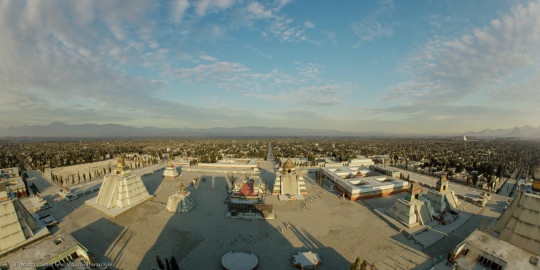

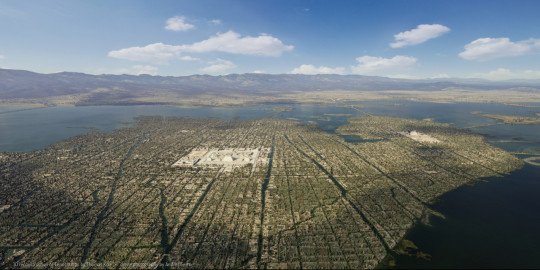
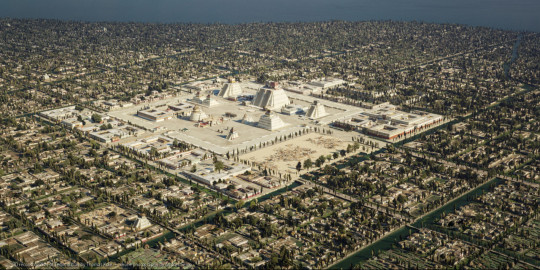


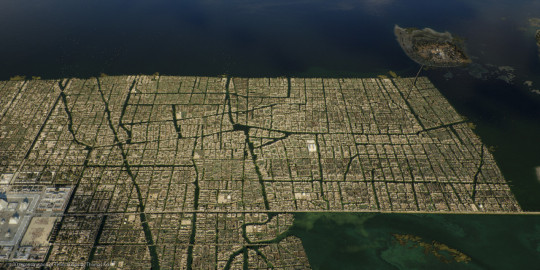



3D Reconstruction of Tenochtitlan, the ancient mexicas Capital city
10 notes
·
View notes
Text

The altepetl (city-states) that made up the Triple-Alliance, nowadays most commonly known as the "Aztecs" though this label is of relatively recent origin and was never in use during their time.
From front to back: Texcoco, Tlacopan, and Tenochtitlan. Their human names are Noxochicoztli, Teoxihuitl, and Matlalihuitl respectively if anyone's curious ;v;
It's important to remember while all three spoke Nahuatl as their main language and shared the same religion, they didn't consider themselves as belonging to the same people. Texcoco was mainly inhabited by the Acolhua, and Tlacopan by the Tepaneca which while sister groups to the Mexica (who mainly inhabited Tenochtitlan and Tlatelolco) they had a distinct history and identity which is beyond the scope of this post but I hope to go over in detail someday. I find a bit of a shame that both Texcoco and Tlacopan tend to be downplayed or ignored in favor of the Mexica when they also contributed a lot to the alliance.
Fun facts(?: the prestige dialect of Nahuatl that was spoken throughout the valley of Mexico at the time is based on the Texcocan dialect. Thought by both native and non-natives alike to the most refined and elegant manner of Nahuatl speech.
In the tributary system both Tenochtitlan and Texcoco would each receive 2/5 of tribute collected, while Tlacopan would receive the remaining 1/5.
#my art#aph texcoco#aph tenochtitlan#aph tlacopan#mesoamertalia#//my brain is so fried and im not very happy with this but I needed to stop and post this or itll be in wips forever 🥲
81 notes
·
View notes
Text

I had the amazing opportunity to be a part of the Wild Westalia Zine hosted by the wonderful @michichi69 !
This is my piece featuring my OCs, Huitzilihuitl (Tetzcoco), Xochitl (Tlacopan), and Tematlalehua (Tenochtitlan).
#hws#hetalia#hws tetzcoco#hws tlacopan#hws tenochtitlan#hetalia oc#hetalia ocs#yaqa draws#hetalia world stars
40 notes
·
View notes
Text
//this blog is still alive I swear. Send asks and I’ll answer away!
1 note
·
View note
Text
Why do some people rage against using the term Aztec, but say nothing when someone uses Maya (multiple cultures), Zapotec (Bën Za), Mixtec (Ñuu Savi Sukun, Ñuu I'ni, Ñuu Andivi), Tarascan (Purépecha), Huichol (Wixárika), Cora (Náayerite), Huastec (Téenek), or any other indigenous groups? Especially when discussing archaeologically defined groups/cultures that may be quite distinct from their contemporary descendants?
I'm not saying that we shouldn't use better terms. We most definitely should. Anasazi, for example, should never be used beyond a single sentence saying it is no longer an acceptable label when reviewing and discussing the historiography of the Puebloan peoples.
But that doesn't mean some terms should be abandoned in lieu of another term that is no way better. Replacing Aztec with Mexica ignores the two other ethnic groups/city-states that made up the Triple Alliance. I want you to stop and think And see if you can recall what those two groups were. I'll give you a hint, Nezahualcóyotl was from one of those groups.
Give up? They were the Acolhua and Tepanec. So, if you want to stop using Aztec, that's fine. But you have to replace it with Mexica, Acolhua, and Tepanec every time. However, that replacement is only limited to talking about Tenochtitlán, Texcoco, and Tlacopan. Why? Because there were more ethnic groups within the Basin of Mexico, not to mention outside the Basin of Mexico, that were under control of the Triple Alliance and were distinct from being Mexica, Acolhua, or Tepanec. You could, of course, replace Aztec with Triple Alliance, or Ēxcān Tlahtōlōyān in Classic Nahuatl. Totally fine if a little unwieldy. Though you may run into issues with people confusing the Triple Alliance of Mesoamerica with several Triple Alliances in European history.
But what really is the issue with using Aztec to refer to the multitude of ethnicities and cultures that made up the Triple Alliance? It isn't derogatory or insulting. The term is based on the semi-mythical homeland of numerous groups that occupied Central Mexico and made up a large part of the Triple Alliance (the Tlaxcalteca were from Aztlan, as well). In fact, Aztec is a handy term to refer to the collection of all these groups despite the polity not being a monocultural entity because these groups did share many cultural features, histories, and/or languages.
You could compare the term Aztec to Roman. A broad term that encompasses many peoples. But when necessary, you can discuss individual or small groups of ethnicities/cultures within the broader polity. And that includes the people of Rome itself which you could refer to as Romani, which they called themselves, to be distinct from the larger broader socio-political Roman label for the people of the Republic/Empire outside of Rome proper.
It's an issue of scale, I think. But that's why we have multiple terms available to use when the context and need arises. And if better terms come along, by all means replace the previous terms.
If you disagree, I would like to know why. This was sort of a rant into the void from seeing other online discourse. I really would welcome a good explanation as to why we should replace Aztec with Mexica at the expense of all the other groups that made up the Triple Alliance.
258 notes
·
View notes
Text
Serpent labret—Mexica (modern central Mexico), 1325-1521 CE
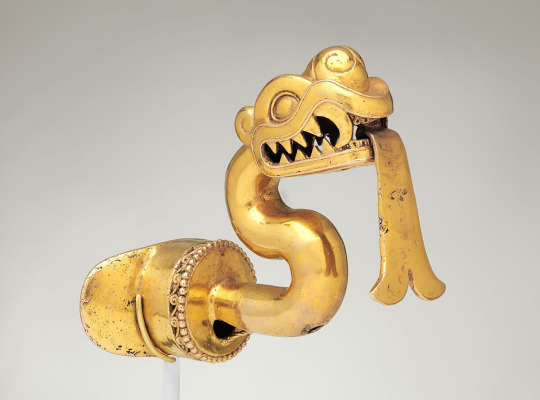
I want to note that although the Met description uses the term "Aztec," the preferred term is Mexica according to what I have read from Mexica people.
According to the Met: "Superbly crafted in the shape of a serpent ready to strike, this labret—a type of plug inserted through a piercing below the lower lip—is a rare survival of what was once a thriving tradition of gold-working in the Aztec Empire. Gold, in Aztec belief, was teocuitlatl, a godly excrement, closely associated with the sun’s power, and ornaments made of it were worn by Aztec rulers and nobles. Historical sources describe a variety of objects made of gold, including a serpent labret sent by Hernán Cortés as a gift to the Holy Roman Emperor, Charles V, yet nearly all of these objects were melted down at the time of the Conquest and shortly thereafter, converted to gold ingots for ease of transport and trade.
The serpent’s head features a powerful jaw with serrated teeth and two prominent fangs. Scales are represented in delicate relief on the underside of the lower jaw. A prominent snout with rounded nostrils rises above the maw of the serpent, and the eyes are surmounted by a pronounced supraorbital plate terminating in curls. On the crown of the head, a ring of ten small spheres and three loops rendered using the technique of false filigree represents a feather headdress with beads. The bifurcated tongue, ingeniously cast as a moveable piece, could be retracted, or swung from side to side, perhaps moving with the wearer’s movements. The sinuous form of the serpent’s body attaches to a cylinder or basal plug ringed with a band of tiny spheres and a band of wavelike spirals. The plain, extended flange would have held the labret in place within the wearer’s mouth.
Labrets, called tentetl in Nahuatl, the language of the Aztecs, were manifestations of political power. The Codex Ixtlilxochitl, an early colonial-period manuscript now in the Bibliothèque Nationale de France, Paris, includes a portrait of the ruler Nezahualcoyotl in full warrior attire, complete with a gold raptor labret (fol. 106r). Nezahualcoyotl was the lord of Texcoco, one of the three cities that formed the Triple Alliance, the union at the core of the Aztec Empire formed by the Mexica of Tenochtitlan, the Alcolhua of Texcoco, and the Tepaneca of Tlacopan. The Aztec title for the royal office was huey tlahtoani, or "great speaker," and the adornment of the mouth was highly symbolic. According to Patrick Hajovsky, a scholar of Aztec art, labrets were the visual markers of the eloquent, truthful speech expected of royalty and the nobility. Crafted from a sacred material, a labret such as this would have underscored the ruler’s divinely sanctioned authority, and asserted his position as the individual who could speak for an empire. Not surprisingly, therefore, the insertion of a labret was part of a ruler’s accession ceremony.
Labrets were also closely associated with military prowess. Specific types of labrets were awarded to warriors based on certain achievements. Gold ornaments, however, appear to have been restricted to royalty and the highest ranks of the nobility, although on occasion gold ornaments could be given by the king as gifts to provincial rulers. Because of its imperviousness to decay, gold would have been an appropriate material to suggest the enduring power of rulers. Such labrets would not have been worn on a daily basis, but rather as part of ceremonial or battle attire donned on specific occasions. Worn on ritual occasions and on the battlefield, this labret, like its wearer, a serpent ready to strike its prey, would have been a terrifying sight.
Serpents have been a favored subject in Mesoamerican art from at least the second millennium B.C. As creatures that could move between different realms, such as earth, water, and sky, they were considered particularly appropriate symbols for rulers and mythological heroes such as Quetzalcoatl, the legendary "feathered serpent." The combination of the curled eyebrow and snout, along with the feathered headdress, may mark this creature as Xiuhcoatl, a mighty fire serpent conceived of as an animate weapon of the Aztec sun god, Huitzilopochtli. Stylistically, this labret has much in common with works in other media, from monumental stone sculptures to a turquoise mosaic double-headed serpent pectoral now in the British Museum (AOA AM 94-634).
Although gold working developed relatively late in Mesoamerica (after AD 600), metalsmiths developed innovative approaches in different regions and produced works of great artistry and technical sophistication. Oaxaca, one of the major sources for gold, was also long considered one of the primary centers for the production of gold objects. Recent research by Leonardo López Luján and José Luis Ruvalcaba Sil, however, has revealed an important gold working tradition in the Basin of Mexico. Small cast gold bells and ornaments of hammered sheet metal have been excavated at Mexico City’s Templo Mayor, or Great Temple, the sacred center at the heart of the Aztec Empire. The finds there include a bifurcated tongue fashioned from sheet gold, and cast-gold bells that once adorned a wolf and an eagle, animals that were sacrificed and placed in one of the Templo Mayor’s dedicatory caches.
Outside of the Templo Mayor finds, the majority of the Aztec works in gold that have survived—including this labret—are ornaments for the royal or noble body. Most Aztec labrets are plain obsidian or greenstone plugs (see, for example, MMA 1979.206.1090-1092), although exceptional examples were made in the form of raptors such as eagles (MMA 1978.412.218; Saint Louis Art Museum 275:1978; Museo Civico di Arte Antica, Turin; see also one in jadeite, MMA 02.18.308). Another serpent labret, possibly from Ejutla, Oaxaca, is now in the National Museum of the American Indian in Washington, D.C. (18/756).
This serpent labret, perhaps the finest Aztec gold ornament to survive the crucibles of the sixteenth century, is an exceedingly rare testament to the brilliance of ancient Mexican metalsmiths. Monumental sculpture in stone, ceramic vessels, and other more durable forms of cultural production shed light on key aspects of Aztec ritual and daily life. But gold, in its infinite ability to be transformed, melted and re-worked, could always be remade to suit current needs, and thus rarely survives from antiquity. Though small, this masterpiece opens a window into Aztec culture at the very highest level, a world almost entirely obliterated when Hernán Cortés arrived on the shores of Mexico in 1519."
10 notes
·
View notes
Photo

The Iberian Conquest of the Americas
European explorers began to probe the Western Hemisphere in the early 1500s, and they found to their utter amazement not only a huge landmass but also a world filled with several diverse and populous indigenous cultures. Among their most important conquests were those of Christopher Columbus in the Caribbean (1492-1502); Hernán Cortés in Aztec Mexico (1519-1521), Francisco Pizzaro and Diego de Almagro in Inca Peru (1528-1532), and Juan de Grijalva (1518) and Hernán Cortés (1519; 1524-1525) in Mayan Yucatán and Guatemala.
Indigenous Peoples of the Americas
The Aztec civilization was located in the Gulf Coast Plains of central America and the high reaches of the Sierras. Their empire was a confederation of three huge city-states established in 1427: Tenochtitlan, the capital located on an island near the western shore of Lake Texcoco in central Mexico, Texcoco in the central Mexican plateau, and Tlacopan in the Valley of Mexico on the western shore of Lake Texcoco.
The Incas were found in the Andes and coastal regions of South America. Their empire arose in the early 13th century and was the largest kingdom in pre-Columbian America, with its capital at Cuzco, in modern-day Peru. The Inca civilization controlled a large portion of western South America through conquest and the collection of tributes from client states.
The Maya civilization had once ranged across southeastern Mexico, all of Guatemala and Belize, and the western portions of Honduras and El Salvador. When the Spanish arrived, the Maya civilization was well past its golden age (250-900 CE) but still had a significant presence in the Yucatan Peninsula and the highlands of Guatemala.
The Taínos and Caribs were widely distributed across the Greater and Lesser Antilles in the Caribbean Sea. These societies did not have a centralized government but were ruled by a myriad of regional hereditary chiefs and noble classes. At the time of Columbus' arrival in 1492, there were five chiefdoms of the Taíno civilization in Hispaniola, each led by a principal cacique (chief) to whom tribute was paid.
The Tupi-Guarani inhabited the Amazon rainforest and most of Brazil's coast. Like the Taíno, the Tupi-Guarani had no central government but were divided into thousands of tribes, each numbering from 300 to 2,000 people. In 1500, the Tupi numbered about 1 million people, nearly equal to the population of Portugal.
Continue reading...
26 notes
·
View notes
Photo
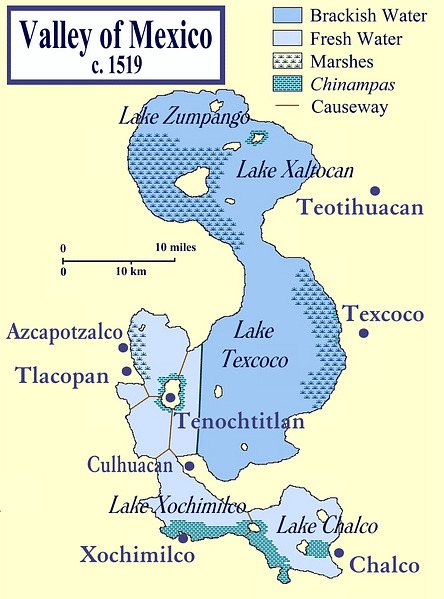
Texcoco
Texcoco (alias Tezcoco ou Tetzcoco), située près des rives orientales du lac Texcoco dans la vallée du Mexique, était la capitale du peuple Acolhua. C'était une puissance notable de la période aztèque et un membre de la Triple Alliance avec Tenochtitlan et Tlacopan. Texcoco donna également naissance à l'un des plus célèbres souverains de Mésoamérique, Netzahualcoyotl, qui dirigea une ville devenue un centre de culture et d'apprentissage réputé.
Lire la suite...
2 notes
·
View notes
Text
Over the years, archaeologists have unearthed many offerings at the Templo Mayor, located at the heart of the ancient Aztec, or Mexica, capital of Tenochtitlán and adjacent to contemporary Mexico City’s cathedral. The most recent, the 186th to date, was announced in August: a stone chest filled with objects from the sea and 15 anthropomorphic sculptures in green stone, dating from the reign of Moctezuma Ilhuicamina (1440–69).
The discovery was made by archaeologists Alejandra Aguirre Molina and Antonio Marín Calvo, working under the direction of Juan Ruiz Hernández of the Proyecto Templo Mayor—an ongoing restoration effort focused on one of the great archaeological landmarks of ancient Mexico. It was founded by Eduardo Matos Moctezuma in 1978 not long after utility workers discovered a statue of the Aztec goddess of the moon, Coyolxauhqui, at the Templo Mayor site. The initiative is currently directed by archaeologist Leonardo López Luján.
The offering was left on a platform on the rear facade of the Huei Teocalli, to use the Nahuatl name for the Templo Mayor, a few centimeters away from an area impacted 123 years ago by the placement of a sewage pipe. The offering box includes 14 anthropomorphic male sculptures and one female figurine. This artifact dates from the time of the first Moctezuma to rule Tenochtitlán, in the middle of the 15th century.
According to the researchers, the sculptures carved from green stone exhibit characteristics of the Mezcala style from the northern highlands of the Mexican state of Guerrero, about 200 miles south of Mexico City. Among these sculptures, one that is 30 centimeters high stands out in contrast to the other figurines that are as small as 3 centimeters tall. All have some unique features, and the style of the figures and their origin in the state of Guerrero has led the archaeologists to speculate that they arrived at the Templo Mayor following the Aztec conquest of the region. Like all Aztec rulers, Moctezuma I Ilhuicamina, whose full name in Nahuatl is Motēuczōmah īlhuihcamīna, was a powerful leader of the civilization which had its capital at Tenochtitlán. He ruled between 1440 and 1469 and was the fifth tlatoani, or ruler of Tenochtitlán. Moctezuma I expanded the territory of his empire through a series of military campaigns and conquests. During his reign, the Triple Alliance (which consisted of Tenochtitlán and the nearby cities of Texcoco and Tlacopan) succeeded in conquering several neighboring peoples and expanding its influence in the Mesoamerican region.
In addition to his military achievements, Moctezuma I is remembered for his focus on the cultural and religious development of Tenochtitlán. He promoted the construction and decoration of many temples and monuments, including the Templo Mayor, the most important ceremonial center of the Mexica civilization. “When the Mexica subdued these peoples, the figurines were already relics, some of them are more than 1,000 years old, and presumably served as cult effigies, which the Mexica appropriated as spoils of war,” explains Luján.
Aguirre and Marín, who also worked with Sofía Benítez Villalobos, a specialist in restoring artifacts, have concluded that, after they were brought to Tenochtitlán, the sculptures underwent a ritual that transformed them and incorporated them into the religious life of Tenochtitlán. They point to traces of facial painting that the Mexica added to the figurines, associated with the god of rain, Tlaloc. In addition to the sculptures, offering 186 included two earrings in the shape of rattlesnakes and a total of 137 beads made of various green stones, accompanied by sand and 1,942 different elements from the ocean including shells, snails, and corals.
Originally from the coasts of the Atlantic Ocean, a region subdued by the Triple Alliance in the time of the first Moctezuma, the seashells have been restored, and the responsibility for their biological identification lies with Belem Zúñiga Arellano, a member of the Proyecto Templo Mayor team.
The discovery of this offering builds on archaeologists’ interest in verifying a pattern observed in earlier offerings, specifically 18, 19, and 97. These consisted of stone chests that were buried as part of dedication offerings under monumental serpent heads located on the platform of the Templo Mayor. All these offerings may provide a better understanding of how the Aztecs viewed the Templo Mayor.
“In the classic Nahuatl language, these chests were known as tepetlacalli, from tetl, or stone, and petlacalli, a box made of mats. In their homes, the Mexica would store their most precious belongings—fine feathers, jewelry, and cotton garments—in chests made from petate (a type of palm). If we look at the Templo Mayor, which represents a sacred mountain full of provisions, we can imagine the priests storing in these ‘stone chests’ the quintessential symbols of water and fertility: sculptures of the rain gods, green stone beads, shells, and snails,” López Luján explains.
By 2024, the Proyecto Templo Mayor plans to ask the Archaeology Council of Mexico’s Instituto Nacional de Antropología e Historia, the government body that administers all of the country’s archaeological sites, for permission to temporarily remove a serpent's head located on the northern side of the Templo Mayor. It is likely that even more treasures will soon see the light of day again.
5 notes
·
View notes
Text
The Poet Prince of Texcoco
“O friends, to a good place we’ve come to live, come in springtime! In that place a very brief moment! So brief is life!” -Nezahualcoyotl
In the downtown Zocalo district, there is a small monument that you could easily miss unless you were looking for it. It is the Garden of the Triple Alliance, a peaceful monument to a violent empire. The Triple Alliance is a term used to describe the trio of Nahuatl city-states in central Mexico, Tenochtitlan (what is now Mexico City), Texcoco and Tlacopan, that together conquered much of what is today Mexico. While their dialects and religions varied slightly, they came from similar ancestors and had similar cultures. This small, quaint garden is a funny way to commemorate an empire that expanded through war and conquest, and would at times require sacrificial victims as tribute. The Alliance’s oppression and subjugation of other Mesoamerican peoples, such as the Tlaxacala and Toltecs, led in part to their fateful decisions to help the invading Spanish. But today this park is a lovely and peaceful spot amidst the chaotic churn of downtown.

Also commemorated in this park is Nezahualcoyotl, the prince of Texcoco. Born in 1402, Nezahualcoyotl (often translated as “Hungry Coyote”) became prince of his territory at the young age of fifteen, but was overthrown and forced into exile. Nezahualcoyotl would spend three years fighting and return with an army of 10,000 soldiers to return his family and regain his throne. As prince, Nezxhualcoyotl supported the artists and philosophers in his kingdom, and encouraged education. In the incredible historical novel Aztec, Nezahualcoyotl is portrayed as a cautious and clever leader, in contrast to the egotistical and ambitious, younger Moctezuma. Rebuffing Moctezuma’s desires to continue to use their armies to expand the empire, Nezahualcoyotl wisely plans to conserve his kingdom’s resources for whatever dark forces are amassing in the east. At that point in the novel (and history), both Moctezuma and Nezahualcoyotl have heard reports of strange, white men appearing on the eastern coast, and Nezahualcoyotl is proven right to view this threat as gravely serious.
There is something romantic, even cinematic, about this figure: A prince in exile, a warrior poet fighting to retake his kingdom. Later a wise, older ruler who can see the danger and destruction that is to come. There is of course, something deeply tragic about Nezahualcoyotl, too: He was a man who may have sensed his civilization would soon face an existential threat, and even with his foresight, knew there was very little he, or anyone, could do about it.
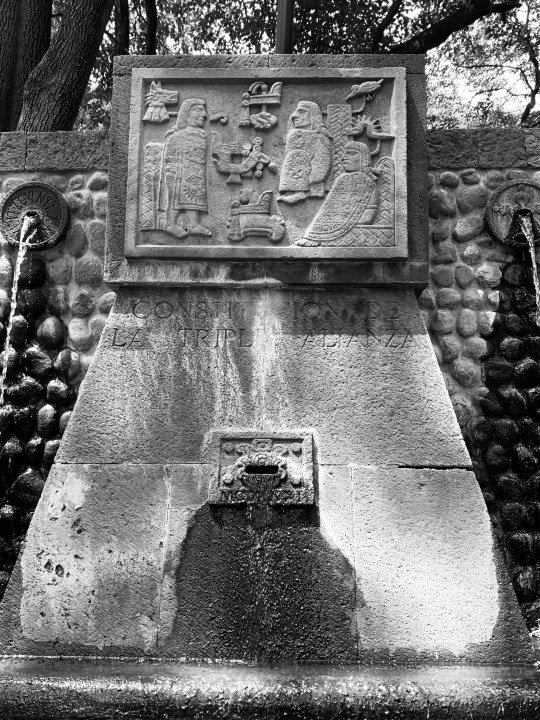
Nezahualcoyotl survives today not just in history, but in his writing. He is considered to be one of the greatest poets of ancient Mexico. The royalty and nobility of the Triple Alliance were expected to be well educated in many subjects, and nobles were taught how to use both the pen and the sword. There are some historical parallels with the samurais of Japan and the scholarly nobles of ancient Greece and Rome. It is amazing that we still have access to his poems, considering that poetry and literature at that time was often times memorized and reproduced orally, as well as the fact that there was great literary and cultural destruction by the Spanish in the generations after the Conquest.
Here is an excerpt of a poem written by Nezahualcoyotl, perhaps reflecting on his own experience of war and reconquest:
The battlefield is the place: where
one toasts the divine liquor in war,
where are stained red the divine
eagles,
Where the tigers howl,
Where all kinds of precious stones
rain from ornaments,
where wave headdresses rich with
fine plumes,
where princes are smashed to bits.
Here is another excerpt of a poem that is kind of like a pre-modern take on “these are a few of my favorite things”:
I love the song of the mockingbird,
bird of four hundred voices;
I love the color of jade
and the drowsy perfume of flowers;
but more than these, I love
my fellow human beings.
In recent years, as Mexico has strived to decolonize their national identity and intentionally celebrate their long ignored indigenous roots, Nezahualcoyotl has been frequently honored as a wise and fair ruler in Mexican history. There is a neighborhood named after him in Mexico City that, true to the character of the man, is home to many artists. He is even honored with his likeness on the 100 peso bill.
But I imagine the actual man would take all this recognition in stride. Like another poet who once famously wrote “nothing gold can stay”, Nezahualcoyotl also wrote about the impermanence and ever changing nature of life:
Truly do we live on earth?
Not forever on earth; only a little while here.
Although it be jade, it will be broken,
Although it be gold, it is crushed,
Although it be quetzal feather, it is torn asunder.
Not forever on earth; only a little while here.

#travelgram#mexico#cdmx#historiamexicana#mexicanhistory#aztec#poesiamexicana#mexicanpoetry#poetry#literature#triplealliance#triplealianza#parks#texcoco#history
5 notes
·
View notes
Text

¡¡Buenas, buenas gente!! Cómo están? Yo espero que muy bien, aquí les traigo un dibujito de Imperio Azteca que siendo sincera fue mi primera ves haciendo músculos y me gustó el resultado.
.
.
.
.
.
.
.
Les platicaré un poquito de por qué hice este dibujo y una de las razones fue que estaba planeado para un proyecto futuro que estaba haciendo pero hubo unos cambios de planes y no queria que este dibujo que me quedo uff se fuera a la basura así que se los muestro.
.
.
.
.
.
.
.
Y como queda un poco de falta de relleno, les contare un poco de esta cultura mesoamericana, así que prepárense para la pequeña clase de historia.
El Imperio azteca surgió en apenas 200 años, gobernó y colonizó la región central mesoamericana en una triple alianza entre los pueblos de Texcoco (acolhuas), Tlacopan (tepanecas) y México-Tenochtitlán. De hecho, Tenochtitlán fue la capital del Imperio completo
A partir de la alianza de las ciudades Tenochtitlán, Texcoco y Tlacopan, crearon un imperio centralizado y teocrático, gobernado por un tlatoani. Tenían una sociedad estratificada, dividida en tres grupos: pipiltin (nobles), macehualtin (gente común) y los esclavos.
La cultura mexica o azteca abarco el periodo comprendido entre el año 1325 D.C y 1521 D.C (casi dos siglos) hasta la llegada de los españoles y su conquista.
#countryhumans#countryhumans art#countryhumans america#historia#country humans#countryhumansimperioazteca
5 notes
·
View notes
Text
Entry 8: Diego Duran on the Triple Alliance
Source = Book of Gods and Rites by the Dominican Priest Diego Duran

By the 16th century, the Mexica peoples made up the population of the Triple Alliance.
More commonly known as the Aztec empire, the Triple Alliance represented three major city states or altepetl (Texcoco, Tenochtitlan, and Tlacopan). The Triple Alliance served as a sort of metropole to adjacent regions which paid tribute in the form of various goods to the Alliance. A primary element of daily life in the cities were outdoor markets. These markets were either weekly or daily and brought in thousands of people to buy cotton cloth, agave syrup, bird feathers, etc.
At the time, Diego Duran–a colonial Dominican Priest–stayed in one of these city states and recorded his observations of the outdoor markets. This written record is from the Book of Gods and Rites (ca. 1576-1579)
Outdoor markets were a significant part of Mexica daily life, as they brought in thousands of people.
Global Historical Significance:
Spread of Christianity with colonisation, leading to an eventual decrease in popularity of local religious beliefs
Creation of new trade networks as goods from periphery regions were brought into the metropole
0 notes
Note
What is your personal opinion about the personality of Spain as it is now and before? Do you send it with someone? I want to know more about Latin American characters like Mexico (personality, its people, if he is a native American or not, what are his thoughts with colonization and how he lives his life today...headcanons) ❤️🙈 i'm sorry and thank you so much
I hope I am understanding this correctly but I am assuming this is about how I headcanon Antonio's personality now compared to the past and my HCs with my Mexico OC
So as for Antonio. I headcanon his personality to be a lot more mellowed out than it was before. He's not nearly as violent as he used to be. He's also not nearly as insecure in his masculinity as he was in the past (I HC Antonio to be trans and have huge masculinity issues). However, he is still an asshole in my opinion. Given that the country of Spain itself does not seem to find any shame in their acts of colonialism, the way that I write Spain is that he typically doesn't either.
Yes, he definitely regrets a lot, but he himself does genuinely believe that he did Latin America a favor. Pride and ego plague him. He is a man with hubris. Because of this, apologies do not exist in his vocabulary. You're better off just asking anyone else for an apology because it won't come from him.
It's a bit hypocritical of him honestly. Because he views the Age of Exploration as an unhappy time and it's a big part of why my interp of Antonio gets antsy when his hair starts to get long. He cannot stand his hair getting long anymore as it reminds him of times he prefers to forget. Despite this, he does not seem to think about that time being unpleasant to the others around him.
Antonio doesn't seem to see the irony in this. If it's pointed out, he denies it. Or he makes up plenty of excuses. Like I said, he's hypocritical. He refuses to see it too.
He's very much someone who is two-faced. And this has been a recent development as he used to be just very transparent with everyone regardless of the consequences. However, you're only likely to get what he genuinely thinks and believes if you're one of his close friends. And he has very few of those. Francois, Gilbert, Portugal, and Lorenzo are the only people who genuinely see every side of him. Belgium and Netherlands I headcanon see it too, but he does still put up walls with him.
Antonio thinks it's easier that way. He's a lot more reserved than he lets others know and puts up a smile when he's able to. Letting people in is dangerous and letting his thoughts out is too. So it's better to hide it all.
NOW, as for my Mexico.
There's a lot of headcanons there but I will share some of the basic stuff. You can ask me for more any time!
My Mexico is the same as my Tlacopan OC. Now I do want to clarify something. I used to have my Tlacopan, Tenochtitlan, and Tetzcoco as triplets. This is because those OCs are not originally Hetalia OCs they're for a video game I'm working on where they are triplets. However, this doesn't make sense in the context of Hetalia due to histories. So they are simply siblings in the context of Hetalia and NOT triplets. Someone sent me an ask about that a while ago and I wanted to clarify.
SO, the reason that it is my Tlacopan OC as Mexico versus Tenochtitlan is because Xochitl is considered the safest option to her government. Because Tematlalehua (Tenochtitlan) is disabled, they don't want her representing the government. And because Huitzilihuitl (Tetzcoco) is openly gay and refuses to Hispanicize more than necessary, they don't find him to be a good option either. Thus, Xochitl (Tlacopan) was made into the representative of Mexico.
She is Nahua. So she is Indigenous. She is very proud of this fact despite everything that has happened to her and the government's continued efforts to erase Indigenous presence in Mexico.
Colonization was very hard for her. It destroys her home and she was already an adult at the time of everything happening. So she was an adult watching her siblings suffer and their people suffer. For this, she absolutely despises Antonio and refuses to play nice with him more than she has to diplomatically. But even then, she's cold towards him and does not give him the time of day.
My Mexico also does not have a good relationship with Alfred(when he is white because I love black/Native Alfred and that would change their dynamic). Their history is way too complicated and extensive with lots of bullshit, subjugation, and screwing over from Alfred.
Xochitl is otherwise a very motherly figure or an older sister type. She practices folk Catholicism and her teotl is Coatlicue. She's very sweet, loves to cook for her loved ones, and is always an open ear when something is wrong. She has a house full of little ceramic chickens. Just very Señora energy.
Xochitl is very dear to me. I love her so much. There's a lot that I could talk about with her but I need something to start with because there's just so much. I'm more than happy to talk about her because she is my beloved.
23 notes
·
View notes
Text
How the Aztec Empire Was Forged Through a Triple Alliance

The Aztec Empire, one of the most influential civilizations in Mesoamerican history, was established through a strategic military and political coalition known as the Triple Alliance. This alliance, formed in 1428, brought together three Nahua city-states: Tenochtitlán, Texcoco, and Tlacopan, which collectively overthrew the dominant Tepanec city of Azcapotzalco. Formation of the Triple Alliance Before the alliance, the Valley of Mexico was under the influence of Azcapotzalco, which ruled through force and tribute extraction. However, the death of its ruler, Tezozómoc, led to internal strife and a power struggle. Seizing this opportunity, the Mexica ruler Itzcoatl of Tenochtitlán allied with Nezahualcoyotl of Texcoco and Totoquihuaztli of Tlacopan to challenge and ultimately defeat the Tepanecs. Structure and Expansion The Triple Alliance functioned as a military and economic agreement, with Tenochtitlán emerging as the dominant power. While all three partners shared in the spoils of conquest, the Mexica gained the largest share, allowing Tenochtitlán to grow into the most powerful city in the region. Through military campaigns, the alliance expanded across central Mexico, subjugating numerous city-states and incorporating them into a vast tribute system. Texcoco contributed administrative expertise, with Nezahualcoyotl implementing legal and cultural advancements. Tlacopan, though the smallest member, participated in military campaigns and shared in the wealth generated from tribute. Downfall of the Empire Despite its strength, the Aztec Empire faced significant internal and external challenges. The heavy tribute system bred resentment among subjugated peoples, some of whom allied with the Spanish when Hernán Cortés arrived in 1519. With superior weaponry, European diseases, and support from indigenous allies like the Tlaxcalans, the Spanish conquered Tenochtitlán in 1521, bringing an end to the Triple Alliance. Legacy of the Triple Alliance Though the Aztec Empire fell, its influence persists in Mexican culture, language, and traditions. The formation and success of the Triple Alliance highlight the power of strategic coalitions in empire-building and governance. Today, its legacy remains a crucial part of Mexico’s historical identity.
#civil rights#ancient civilizations#pvp civilization#modern history#human history#archaeology#culture
1 note
·
View note
Text
Which is the best station icon?




No propaganda submitted
Icon meanings:
Cuatro Caminos: EN: Icon depicts the dome of the former Toreo de Cuatro Caminos. Name references the area, known as Naucalpan (from nahuatl nau "four", calli "house", and pan "place", or from nau campa "four paths"). Icon references the Toreo de Cuatro Caminos, a bullring formerly located nearby. ES: Ícono representa el domo de lo que fue el Toreo de Cuatro Caminos. El nombre es en referencia al área, llamada Naucalpan (posiblemente del náhuatl, nau "cuatro", calli "casa", y pan "lugar", o nau campa "cuatro caminos"). El ícono es en referencia al Toreo de Cuatro Caminos, una plaza de toros antes localizada cerca de la estación.
Panteones: EN: Icon depicts a crypt gravestone. Icon and name reference the nearby graveyards: Panteón Español ("Spanish Graveyard"), Panteón Francés ("French Graveyard"), and Panteón Alemán ("German Graveyard"). ES: Ícono representa la lápida de una cripta. El nombre e ícono son en referencia a los panteones (cementerios) de la zona: El Panteón Español, Panteón Francés, y Panteón Alemán.
Tacuba: EN: Icon depicts 3 osier or willow flowers. Name references the neighbourhood of Tacuba, formerly a separate town near Mexico City. Icon references etymology: Tacuba from "Tlacopan" (either "place of osiers" or "flowery land"). ES: Ícono representa 3 flores de mimbre. El nombre es en referencia a la colonia de Tacuba, antes un pueblo separado, pero cercano a la Ciudad de México. Ícono es en referencia a la etimología: Tacuba de "Tlacopan" ("lugar de mimbres" o "tierra florida").
Cuitláhuac: EN: Icon depicts a shield. Name references Cuitláhuac, penultimate emperor of Mexico-Tenochtitlan, who expelled the Spanish expedition from the city. Icon references the shields used by mexica warriors. ES: Ícono representa un escudo. El nombre es en referencia a Cuitláhuac, penúltimo emperador de México-Tenochtitlán, quien expulsó a la expedición española de la ciudad. El ícono es en referencia a los escudos usados por los guerreros mexicas.
#mexico#méxico#cdmx#ciudad de méxico#mexico city#public transport#transit#graphic design#poll#metro stations#tournament
1 note
·
View note
Text
TRAVEL & TOURISM (WEALTHYCLUSTER)
Mosaic Zan
Mosaic Zan commoni
Mosaic sung
Mosaic Zan mitzyananquili
Mosaic Santisima
Mosaic emerald
Mosaic Holy Mary
Mosaic aya ypalnemoa
Mosaic aya moxochiuhaya
Mosaic zan nicuicanitl
Mosaic Tollan aya huapalcalli
Mosaic aya; zan
Mosaic Zan temomac
Mosaic aya
Mosaic celia
Mosaic Tlapallan aya mochieloca
Mosaic Philadelphia
Mosaic zan iquetzal
Mosaic Tlacopan
Mosaic zan nimitzahahuiltiaya
Mosaic mamani
Mosaic zan nicaya
Mosaic zan nomac
Mosaic yan aya
0 notes